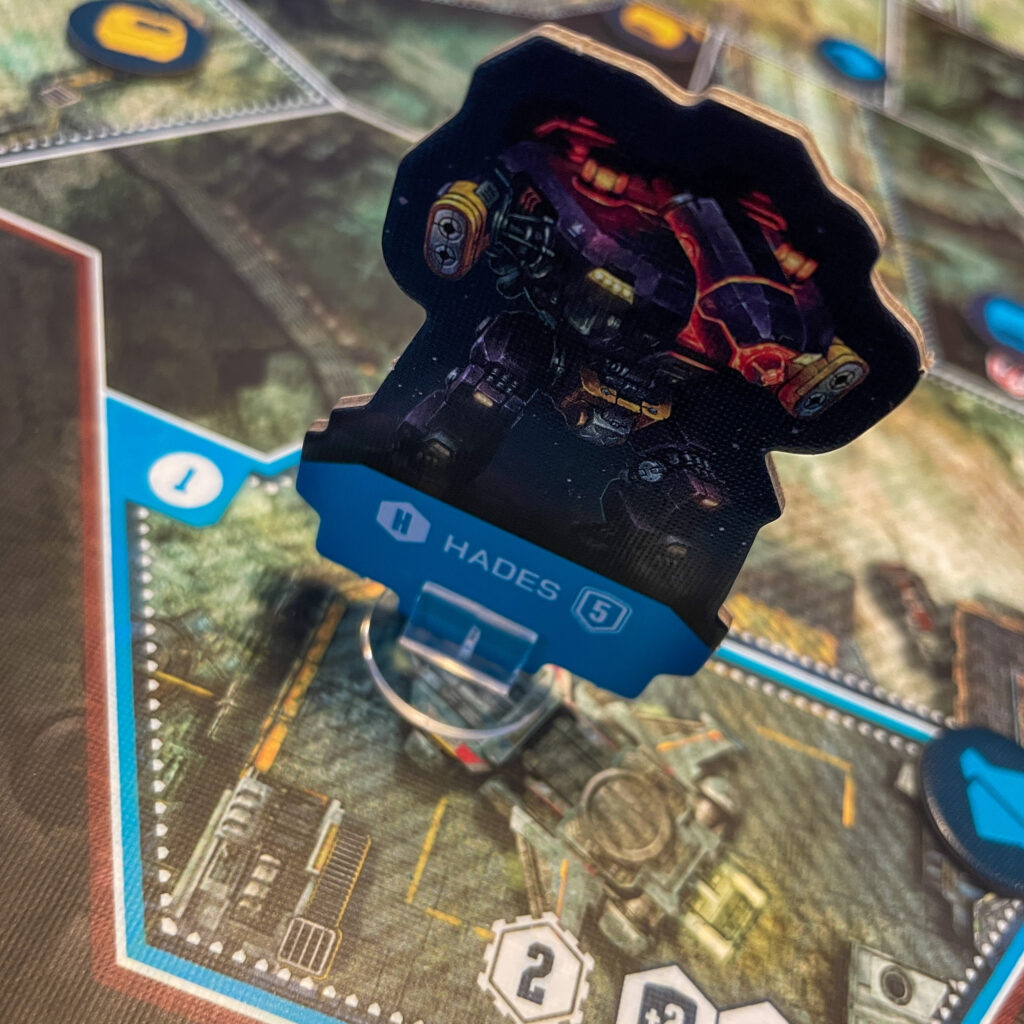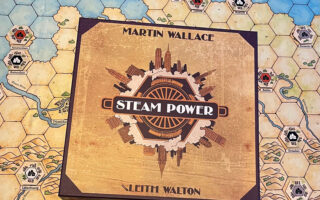
Game summary
👥A game for 1 – 4 players
⏳Play time around 45 – 60 minutes
🏢Publisher is Osprey Games

Introduction
On Jupiter’s moon Callisto, corporate ambition has collided with rebellion. What started as a peaceful mining base has exploded into a warzone. Protests turned to strikes, contracts crumbled, and now armed security, combat-ready mining rigs, and revived military mechs are taking the stage. The corporations want control. The workers want freedom.
The battle for Callisto is on. Choose your side.

Let’s get it on the table
Undaunted 2200: Callisto is a one- to four-player deckbuilding game.
The setup is similar to other games in the Undaunted series, but because of the space combat themes, there are unique elements that do not appear in the other games.
You start by choosing a scenario from the scenario book, placing the corresponding double-sided board (one of four) in the center of the table, and setting up the cards, tokens, and control markers on the board according to the scenario.
Each player then selects a faction, either the LFA or the Breakers, and gathers the starting deck, supply pile, and any scenario-specific cards. You build your decks according to the rules: cards for your starting deck, supply piles, and any removed cards as instructed by the scenario.
Once you have chosen the scenario, the book provides everything you need: the correct board, the starting positions of both factions, which cards and tokens to set up, and, of course, the mission objectives.
Next, place the indicated board on the table and position all unit tokens and objective markers exactly as shown in the scenario. Make sure all control, suppression, and damage tokens are within easy reach. Using small trays or bowls helps keep everything organized.
Then, prepare each faction’s deck. Gather the cards required for the scenario and divide them into three piles: your starting deck (shuffle and draw four cards to begin), the supply (from which you can recruit new cards later), and an empty casualty pile. Lay these piles out clearly for easy access.
Now get the dice ready, the d8, d10, and d12, so you can quickly grab them during combat. Also keep a player aid or this setup guide at hand so you don’t need to constantly reference the rulebook. The dice are used as follows: d8 → for shooting upwards at enemies on higher ground, d10 → standard for equal height, and d12 → for shooting from above.
Finally, each player selects one card from their hand for the initiative phase. Reveal the cards simultaneously; the player with the highest value takes the first turn. That card cannot be used for the rest of the round. With this, you are ready to begin: perform your actions, discard used cards, draw new ones, and repeat until a player achieves victory.

Let’s play
Undaunted 2200: Callisto is a standalone board game in the popular Undaunted series. Instead of historical battlefields, this edition takes the action to the icy moon of Callisto in the year 2200.
In this game, you take command of one of two factions:
Lunar Frontier Authority (LFA) – a corporate security force.
Inter-Jovian Mining Union (Breakers) – a group of rebellious miners.
Their conflict leads to intense battles between mechs and mining vehicles with a sci-fi twist.
The game unfolds over a series of fast-paced rounds. Each round follows a familiar rhythm, and once you get into the flow, it plays smoothly and intuitively.
At the start of each round, both players draw four cards from their personal deck. That deck represents your army, with each card standing for a unit on the board such as a Commander, Gunner, Pilot, or Technician. These cards are not just your troops but also your command structure, meaning your options depend entirely on the cards you have in hand.
Next, you secretly choose one card and place it facedown in front of you. This card determines who will have initiative. The player with the highest value gets to act first. The twist is that you cannot use that card for the rest of the round, so you constantly need to weigh whether it’s better to go first or to save your strongest card for later. Of course, this also depends on your opponent’s moves, as you might be forced to discard a card if one of your units takes damage.
Once both initiative cards are revealed, the player with the highest value begins. Players then take turns playing cards and performing their corresponding actions. These actions can include moving units across the board, attacking enemies, securing new areas, or using your Commander to draw additional cards and open up new possibilities.
Each card is directly linked to a specific unit on the board, making the game feel like a tightly coordinated battle between two commanders directing their forces.
When combat begins, the tactical side of Callisto really shines. You look at both the distance and the elevation between your unit and the target. If you are positioned higher, you gain an advantage and roll a larger die, a d12 instead of the standard d10. If you are lower, you use a d8, which reduces your chance to hit.
This simple rule adds a lot of tension and positioning strategy. Every space on the board matters, and a well-placed mech can make the difference between a winning strike or a devastating miss.
When you hit an enemy, your opponent removes one of that unit’s cards from their deck. The morale and coordination of that squad are literally being thinned out.
Once all of a unit’s cards are gone, the corresponding token is removed from the board. You’re not just losing a piece of plastic or cardboard, but an actual functional unit within your overall strategy.
When both players have played all their cards, the round ends. The used cards go into your discard pile, and then you draw four new cards to start the next round. The game continues like this until one of the players meets the scenario’s victory condition, for example by holding a certain number of control points or dealing enough damage to the opponent.

The Game ends
The game ends as soon as a player achieves the scenario. After this, you move on to the next scenario.

Final Conclusion & rating
Weight: 2.78/ 5
Replayability: 8
Our rating: 7.5 out of 10 dices
After playing Undaunted: Battle of Britain, which was our first introduction to the Undaunted series, we were very curious about this new space edition.
Fortunately, the core rules remain familiar, but there are also a few new elements and actions in this version. In addition to moving your tokens, you can now control robots, and combat takes place on different height levels using different dice, allowing you to shoot at opponents who are higher, lower, or on the same level as you.
The shooting mechanism itself works the same way as before, but depending on whether you’re firing up or down, you use a different die. This small change makes the combat system feel nicely refreshed and dynamic.
Unfortunately, the rulebook isn’t as clear as we’d hoped. There are still some points that feel a bit ambiguous, for instance, whether certain actions are allowed in specific situations. That’s a shame, but once you make some clear agreements with your opponent, it’s easy enough to make it work.
What we do really appreciate, though, is that instead of using separate tiles, Callisto features four double-sided boards with unique layouts. That makes setup much faster and gets you playing right away.
This edition can also be played in teams, either 2 vs 2 or 1 vs 1. We’ve only tried the 1 vs 1 mode so far, since the team version doesn’t appeal to us as much, but that’s purely a personal preference. We also haven’t tried the solo mode yet.
The artwork looks great, although after a while the board can feel a bit repetitive, even with the different layouts for each scenario.
And as with every Undaunted game, the most important thing to remember is this: shooting isn’t always the fastest path to victory. Many scenarios can be won by cleverly capturing and holding the objectives instead.
We definitely enjoyed this edition, but we still prefer diving back into the WWII versions, there’s plenty left to explore there.
Thanks to Osprey Games for this review copy and the opportunity to write about it.








